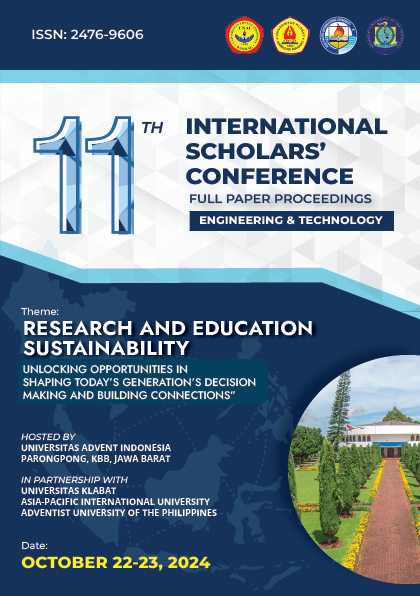Application of Program Evaluation Review Technique (PERT) and Critical Path Method ( CPM) on Enrollment Processes in the Adventist University of the Philippines
Keywords:
Program Evaluation Review Techniques (PERT), Critical Path Method (CPM), AUP Enrollment ProcessesAbstract
This study provides a comprehensive analysis of the enrollment process in the Adventist University of the Philippines and recommends improvements based on the Program Evaluation Review Technique (PERT) and Critical Path Method (CPM). Using the PERT and CPM, key activities in the enrollment process were identified as critical, as follows: (1) approval of the request for residence category; (2) creation of course lineup; (3) approval of course lineup; (4) assessment of account by the Accounting Office; and (5) tagging of the student as officially enrolled. The study on the enrollment process at the Adventist University of the Philippines used a quantitative approach for data collection and analysis. Data were gathered from 128 college students enrolled during the second semester of the 2023-2024 school year. The data collection process was conducted through face-to-face interactions or by sending information electronically via social media platforms.Out of the 128 collected samples, only 101 samples were retained for analysis after removing incomplete or negative values. The key data collected included the dates and times associated with various steps in the enrollment process, such as updating the student profile, approval processes, course lineup creation, and final tagging as enrolled. These data points were used to generate a Program Evaluation and Review Technique (PERT) and Critical Path Method (CPM) diagram to identify the critical activities, bottlenecks, and potential improvements in the enrollment process.The analysis of the data involved descriptive statistics, including the calculation of average durations and standard deviations for each step, and the Z-score analysis to predict the probability of completion times for the enrollment process. The study revealed that the critical activities in the process included course lineup creation, approval steps, and assessment by the accounting office, with a 50% probability of completion in 5 days and 71.68% probability in 7 days. Based on the results of this study, it is recommended to Conduct a survey on student satisfaction with the enrollment process.
Downloads
References
Abulencia, J. P. (2016). Critical Path Method (CPM) and Program Evaluation and Review Technique (PERT) Applications in Construction Project Management. Master's thesis, Mapua Institute of Technology.
Adorable, R. P. (2013). Enhancing the Enrollment Process of a State University through the Application of Project Management Techniques. International Journal of Scientific and Research Publications, 3(6), 1-7.
Aduana, N.L., Management Science: A Quantitative Approach to Decision-Making, C & E Publishing, Inc., Quezon City, 2021.
Al-Azawei, A., Serenelli, F., & Lundqvist, K. (2016). Evaluation of the e-portfolio application process in higher education: A case study. In 2016 International Conference on Education and New Learning Technologies (Educational Technology & Computers) (pp. 557-566). IATED.
Al-Hosni, S., & Al-Balushi, K. (2015). Evaluation of the efficiency of the registration process at Sultan Qaboos University using PERT and CPM. International Journal of Engineering and Technology, 10(4), 174-180.
Cavalcanti, J. M., Borges, L. R., & Ferreira, L. M. (2018). Simulation of the enrollment process in a private university using the combined PERT-CPM-Monte Carlo methodology. In 2018 IEEE 20th International Conference on Information Reuse and Integration for Data Science (IRI) (pp. 53-57). IEEE.
Chan, A. H. C., & Chan, K. W. (2010). A PERT/CPM approach for improving the efficiency of the admissions process in Hong Kong higher education institutions. International Journal of Information Management, 30(4), 317-323.
Goudarzi, M., & Jabalameli, N. (2011). Evaluating the efficiency of the enrollment process by using PERT and CPM techniques. Journal of Applied Sciences and Technology, 2(1), 10-
Hwang, H., Lee, H., & Shim, J. (2017). Applying the critical path method (CPM) to the graduate school enrollment process. Journal of Applied Management and Entrepreneurship, 22(1), 23-38.
Hwang, H., Lee, H., & Shim, J. (2017). An application of the critical path method (CPM) to the enrollment process in a graduate school. Journal of the Korean Society for Admission and Academic Counseling, 16(2), 133-147.
Kerzner, H. (2017). Project management: a systems approach to planning, scheduling, and controlling (12th ed.). John Wiley & Sons.
Mahmood, A., & Soomro, S. (2018). Evaluation of Admissions Process using PERT and CPM Techniques. International Journal of Information Technology and Computer Science, 9(1), 1-6.
Moder, J. J., & Phillips, D. L. (1970). Project management: planning and control techniques. Krieger Publishing Company.
Modi, P.N., Sanjeev Modi and Rajeev Modi, PERT and CPM, Program Evaluation and Review Technique and Critical Path Method, New Delhi, Standard Book House, unit of: Rajsons Publications Pvt. Ltd., 5th Edition, 2012.
Punmia, B.C. and K.K. Khandelwal, Project Planning and Control with PERT and CPM, Laxmi Publications (P) Ltd., New Delhi, 4th Edition, 2002.
Santos, S. C. N., & Bautista, R. V. (2014). Project Management Techniques in the Philippine Construction Industry. Journal of Engineering Research and Applications, 4(1), 407-412.
Sarjono, Haryadi and Vivi Dwi Kurnia, A Systematic Literature Review: Optimization of Implementation of Project Development in the Company with PERT and CPM Method, Proceedings of the 2nd Indian International Conference on Industrial Engineering and Operations Management, Warangal, Telangana, India, August 16-18, 2022.
Sharma, S.C., Operations Research, PERT, CPM, and Cost Analysis, Discovery Publishing House, New Delhi, 2006.
Tavana, M., Khalili-Damghani, K., & Hajiaghaighaleh, N. (2017). An application of project management techniques in the registration process of a university in the US. Journal of Applied Research in Higher Education, 9(1), 1-14.
Downloads
Published
How to Cite
Issue
Section
License
Copyright (c) 2024 11th International Scholars Conference

This work is licensed under a Creative Commons Attribution-ShareAlike 4.0 International License.
Copyright © 2024 ISC Committee.















